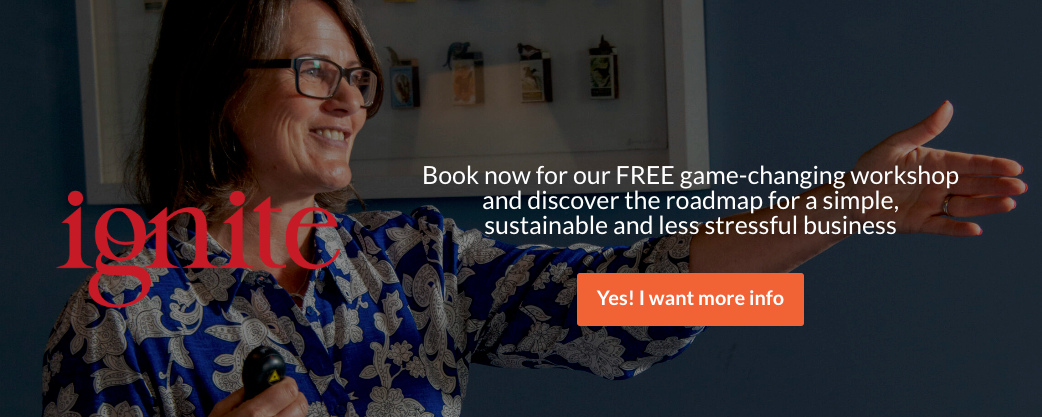Have you ever stopped to think why you run your business the way you do?
Most people have ended up with their current model based on one of two reasons;
- It’s because it’s what everyone else in your profession is doing
- You’ve followed advice to teach you what is the most profitable or easiest to run
Running your business like everyone else
First, you may have the same business model as everyone else in your profession, not because of choice but because you don’t know any better. There’s no judgment here; what you don’t know, you don’t know. You may have spent a lot of time learning about marketing and getting clients, but you’ve probably never given much thought to how to design, set up and run your business.
Doing what everyone else in your profession does has its upsides because you know what works already. Why reinvent the wheel? However, there is a big problem with this. Just because most of your colleagues or competitors run their business in a particular way doesn’t necessarily mean they are all doing it correctly.
But … 80% of your profession are doing it wrong
If we take the Pareto Principle, which statistically proves that 80% of output comes from 20% of input, then we could theorise that 80% of the success in your profession comes from just 20% of businesses in that profession.
If we flip this the other way, 80% of businesses in your profession create just 20% of the output.
Hmmm …
Let’s stop and think about this and wonder how true this is.
Could we conclude that no matter which profession or business sector you operate in, too many people seem to be struggling? Look around at the faces at your next networking event or industry conference; how many of those businesses would you say are flourishing?
The reality is that many are experiencing one or more of the following:
- Overwhelm; procrastination over marketing initiatives and new product ideas because busy-ness is taking over the day-to-day, and there’s no space to work creatively on projects that will grow the business
- Overworked; stuck in the never-ending to-do-lists and client delivery
- Underpaid: competing on price and charging by the hour or the time spent with clients, which often leads to over-delivery and doing far more than initially promised to try and keep clients happy
This paints a pretty depressing picture, especially if you realise you may be in this average 80%!
What about the top 20% of your profession?
Are they creating 80% of the output?
There will be, of course, all sorts of reasons for the success of these top 20%, and yes, there is every chance that they are using technology to create massive growth advantage opportunities to allow them to stand out as leading experts in your profession.
You’ve probably already seen colleagues and competitors create new ways of sharing their expertise. From expanding their offerings to serving groups of clients, large and small, through to creating digital content and cutting-edge use of AI, the opportunities to do something ‘different’ and grow the number of clients you work with are open to you if that’s what you want.
This leads me to the second instance, where many of you may choose your business model based on what’s been taught to you as the most profitable or easiest to run.
Running your business because you’ve been taught this is the way that will make you the most money
The internet became mainstream in the late 1990s, changing our lives. When I started my first business in 2004, email marketing and blogging began emerging for small businesses. When the doors opened to mainstream social media sites, such as Facebook and Twitter, digital growth skyrocketed and advances in technology today, don’t seem to be showing any signs of slowing down.
Unsurprisingly, the explosion in selling digital content since 2015 has led to tens of thousands marketing experts teaching digital ways of making money and growing a business from your laptop on the beach, particularly within the consulting and coaching professions.
Because technology has been the reason for the success of a lot of businesses which are very visible online, it’s easy to get sucked into believing that digital is the only way to grow a business.
But this is simply not the case.
Many marketplaces are now flooded with digital offerings that it’s hard to break in and claim your space, especially when so much of the content can be of poor quality. Your client base may already begun to distrust this form of learning or support. I am sure you have already experienced digital learning and Zoom fatigue over the past few years.
You also have to consider that plenty of businesses in this top 20% bracket are running different or more traditional business models. You may not even realise they exist because you don’t get to see their marketing campaigns or brand presence on your Facebook or Instagram feed.
I remember a client told me once that she was impressed by the number of people I would attract at my live training events despite her needing to see more marketing about it. She wasn’t seeing it because I wasn’t targeting her; she was already my client. So be aware that there is plenty of success around you that you are not even aware of; because it’s not being marketed to you, you don’t see it.
Let’s get honest about how it is to run a top 20% business.
On paper, you may have a business that is well within your profession’s top 20%, especially if you are measuring its success on key performance indicators such as turnover, market share or social media followers. But, if you are a regular reader of my blogs and articles, the reality of trying to run a business in the top 20%, measured in this way, is that it may be burning you out.
If you feel you may be getting burnt out by trying to run a business in the top 20%, you will probably be experiencing one or more of the following:
- You’re overwhelmed; you’ve stepped up and created your expert status but don’t like the visibility and constant pressure to perform.
- You’re overworked; you can’t keep up with what you’ve promised your clients and can’t come up for air long enough to hire the right people to help you grow.
- You’re underpaid; your turnover may be great, but there’s not much left for you once you’ve paid your team, advertising invoices and running costs.
Again, another depressing picture, perhaps.
But you won’t be the only one to have created a business that is burning you out because this practice of growing a business based on following someone else’s formulas and business model is rife.
This is why I want you to see the possibilities available by a business model that allows your business to give you the time, money and energy you want and not have it running you into the ground.
You have a choice.
It may be that you are still looking for a formula to follow because you don’t know which direction you should be going in. And creating a formula for your success is what I want to help you with, but based on a choice that gives you the freedom to grow.
You have a choice on what business infrastructure, processes and team to have in place to give you the right business to help you achieve your creativity, purpose and money aspirations to be your authentic self, do good in the world and make money in the process.
You can choose the design, setup and how you run your business based on how you want success to look for you, just the way you can decide on the right car to drive every day.

Choosing which car to drive is similar to choosing what kind of business to run
There are so many different types of cars on the road because each of us has another reason for choosing our mode of transport and to varying stages of our lives.
Starting out, you’ll probably drive any car you can afford, a small hatchback, or even stick to your bike, especially if you live in a city. Families may drive a big SUV. Some may like fast cars. Others choose their mode of transport based on environmental impact and may even decide they don’t want to own a vehicle and instead use Uber or rental cars for longer journeys.
No one car is right for everyone.
And so it is with your business model.
You can decide on several different business models, but that’s not to say you have to pick just one.
You’ll likely decide you want a hybrid, like many electric cars are entering the market. But a word of caution here: be careful of mixing in too many as you may be in danger of creating a convertible SUV that runs on pedal power; no matter how innovative that may be, you’ve got very little chance of getting it off your driveway!
There’s every chance your business model will also change and evolve as you go on your business journey, just as a couple may swap their compact convertible for an SUV when they begin their family, or a city dweller who relies on their bike may realise they need a car when they move out to the suburbs.
As you and your business grow, you may develop new skills or be attracted to new marketplaces and audiences. You will also stretch your thinking over the years and imagine more significant and different opportunities as you grow confident and shift many limiting beliefs.
So, it’s essential to know that your choice of business model becomes part of your longer-term thinking. You may even need to swap your small hatchback for that super fast sports car quicker than you thought if your business takes off!
If you would like to know more and want help with how you shape the way you run your business, then I invite you to join me on my next live Ignite Workshop. It’s a great place to learn more about how business can work FOR you rather than have a business that works you into the ground.
Click here to see the next dates and book your place.
Meanwhile, I hope this has helped you step back from doing what 80% of your profession does or try to work hard to follow the latest marketing formulas and digital trends.
Has this opened your eyes to realising that you can grow a business to suit you and how you work best?
Until next time,









